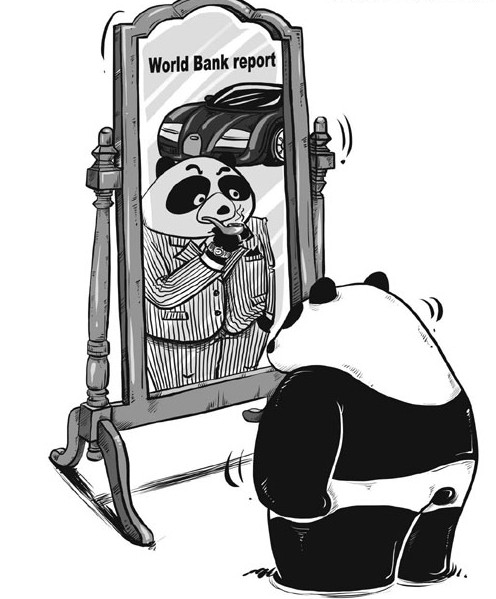

Wang Xiaoying/Chinadaily
A new report by the World Bank's International Comparison Program (ICP) suggests that the purchasing power of the Chinese currency, based on 2011 prices, is significantly stronger than exchange rates indicate. If measured by the yuan's purchasing power, the report concludes, China will soon become the world's largest economy.
China's National Bureau of Statistics participated in the study, but rejected its conclusion, expressing "reservations" about the study's methodology.
The ICP provides useful data to compare living standards in different countries. But if it is used inappropriately to compare economies, the conclusions will be flawed.
Initially, the ICP, which is implemented every six years, was designed to make possible comparisons of living standards in different countries, which are characterized by broadly varying prices.
The ICP figures are estimated according to purchasing power parity (PPP), which compares buying power in different countries. However, despite the unprecedented growth, per capita income differences (at 2005 PPP) remain deep between China and advanced economies. In 1980, just before Deng Xiaoping announced the reform and opening-up policies, China's per capita GDP (PPP) was $253. In the United States, the comparable figure was $12,576, in Japan, $8,611 and in Europe, somewhere between the two. In other words, living standards in China were then only 2 percent of those in the US, and 2.5-3 percent of those in Europe or Japan.
Last year, the comparable per capita income in the US was $51,749, in Japan, just less than $36,000, in the European Union, about $34,500, and in China, less than $9,900. By this measure, living standards in China are 20 percent of those in the US, and close to 30 percent of those in Japan or the EU, on average. Living standards in the US remain five times higher than those in China, and those in Japan and EU are more than three times as high as in China.
Furthermore, the concept of PPP allows us to compare individuals' and households' living standards in different countries. But it should not be used to compare different aggregate economies. After all, the PPP concept is not useful when you travel abroad. As every tourist knows only too well, foreign destinations do not exchange money on the basis of PPP. Only hard cash will do.
Based on GDP per capita (nominal), living standards in China are still only 12-13 percent of those in the US and Japan, and about 19 percent of those in the EU. China's economy will catch up with the US in due time. But it will take far longer for Chinese per capita income to catch up with that in major advanced economies.
Then, there is the issue of size. When Britain industrialized and its urbanization rate exceeded 50 percent, the size of its population was barely 30 million. The US achieved that rate in the 1910s, when its population was barely 100 million. In contrast, when China achieved a comparable rate in 2011, its population was 1.3 billion.
Also, industrialization and urbanization tend to go hand in hand with unbalanced development and income polarization. Moreover, when the UK and the US industrialized, per capita income differences were not as steep across and within countries as they are today.
Because of its population, regional divergence has been particularly steep in China. In 2013, per capita GDP (PPP) was $21,400-$23,300 in Tianjin, Beijing, and Shanghai, less than $8,000 in Sichuan, Jiangxi and Anhui provinces, and less than $6,000 in Yunnan, Gansu and Guizhou provinces.
In other words, per capita income (PPP) in the poorest Chinese administrative regions is 25-30 percent relative to the more prosperous provinces and regions. That ratio, in turn, is comparable to one between the overall living standards in China relative to the US, the EU and Japan.
If it is misguided to compare entire economies on the basis of PPP and Chinese living standards remain a fraction of those in advanced economies, why are PPP figures used to compare economies?
First, the practice may be misguided, but is very much in self-interest. Take, for instance, climate change. In advanced economies, climate change is often defined in terms of aggregate economies, which downplays the fact that, on a per capita basis, advanced economies are causing much more pollution.
Second, misguided comparisons steer attention away from absolute and relative poverty in emerging economies. The World Bank measures international poverty by $1.25 (7.81 yuan) per day, which is not enough for a single meal in China, not to speak of housing or other expenditures.
Perhaps there is something inherently outrageous in major advanced economies to be increasingly concerned about poor countries becoming too prosperous, but not about rich countries being too wealthy-or too pricey even for their own good?
Don‘t read too much into PPP ranking
2014-05-05Claim of China‘s economic supremacy greeted with doubt
2014-05-08China‘s GDP to overtake US in 2022
2013-11-21China to surpass US economy by 2017
2013-02-05Copyright ©1999-2018
Chinanews.com. All rights reserved.
Reproduction in whole or in part without permission is prohibited.